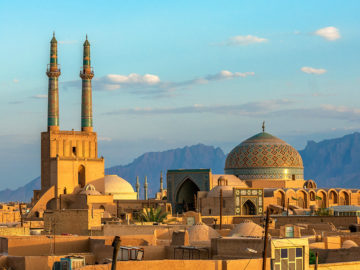
Dakhmeh or Tower of Silence is a place used by Zoroastrians to place the corpse of deceased. The body of a dead person is considered to be polluted, and left on a stone in the highest part of a hill to be eaten by wild animals. In Zoroastrianism, the elements are sacred and must be saved from pollution; therefore, the body that is the epitome of pollution can’t be buried under the soil or burned by fire and is left on a stone platform away from the city until nothing is left but a mass of bones, then the bones are placed in a small pit in the middle of the tower.
The burial ceremony begins in the foothill when the family of the deceased say their final goodbye and then the body is carried by two members of the family to the tower accompanied by a priest and two of tower’s keepers. Beside the keepers, no one is allowed to enter the tower, so the body is given to them outside the tower’s door and then carried to the tower by the keepers.

Dakhme or Dakhneh means the house of evil and although today the word is used to refer to scary places it was originally meant a place of burning, a place that was used by Arians for burning the bodies of the dead. When Zoroastrianism became the main religion of the country the burning places were turned to towers of silence. Whether made by human or as a result of a natural phenomenon, they were made to be easily accessible by the animals and therefore were mostly roofless with small holes in the surrounding walls. They were made outside cities and villages over hills so that the smell and possible pollution wouldn’t reach the city.
The tower is a circular construct where the floor is covered with stones and there is a pit in the middle. The pit was used for the bones of the commoners whereas the royals and nobles were placed in Ostudan that were hand carved holes on the mountains, the best example of which is the Naghsh-e Rostam of Fars Province.

Yazd’s Towers of Silence are a a pair placed on the top of a hill in the southern parts of the city. As a city with the highest population of Zoroastrians, it is considered a traditional Zoroastrian place among all Iranian. The tradition is no longer observed as before but the area surrounding the city is still used to bury the deceased in cemented cells. The towers are not used anymore and have turned into a tourist attraction.

